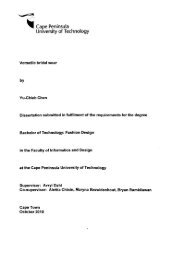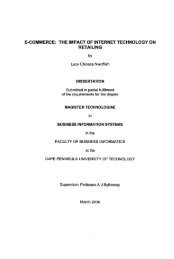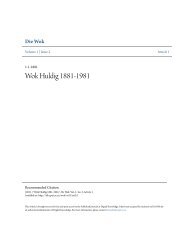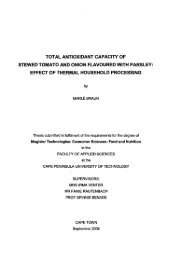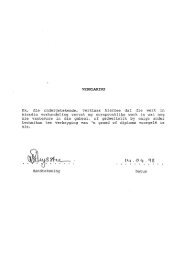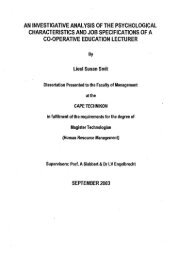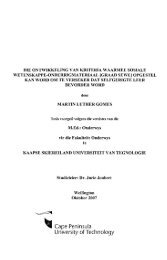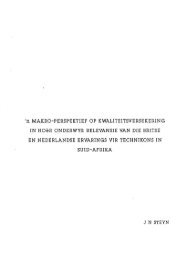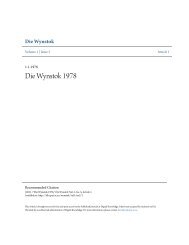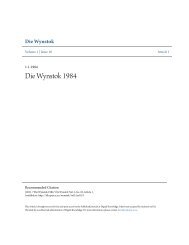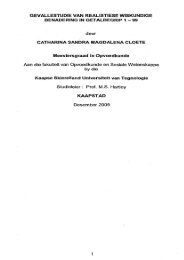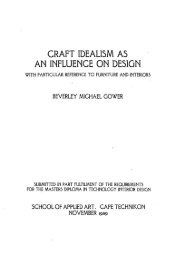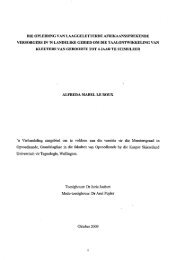the effect of the particle size distribution on non-newtonian turbulent ...
the effect of the particle size distribution on non-newtonian turbulent ...
the effect of the particle size distribution on non-newtonian turbulent ...
You also want an ePaper? Increase the reach of your titles
YUMPU automatically turns print PDFs into web optimized ePapers that Google loves.
Chapter 4 Results and Analysis Page 4.2<br />
Mo<strong>on</strong>ey (1931) (Secti<strong>on</strong> 2.6.2 - Figure 2.5) in that <str<strong>on</strong>g>the</str<strong>on</strong>g> relati<strong>on</strong>ship between <str<strong>on</strong>g>the</str<strong>on</strong>g> shear stress<br />
and shear rate is independent <str<strong>on</strong>g>of</str<strong>on</strong>g> <str<strong>on</strong>g>the</str<strong>on</strong>g> diameter in larninar flow. This was true for all tests<br />
c<strong>on</strong>ducted, where pipediameter had no influence <strong>on</strong> wall shear stress at a given pseudo-shear<br />
rate in <str<strong>on</strong>g>the</str<strong>on</strong>g> laminar regime. This indicates that <str<strong>on</strong>g>the</str<strong>on</strong>g> slurry properties were time independent.<br />
In larninar flow, <strong>on</strong> physical observati<strong>on</strong> <str<strong>on</strong>g>of</str<strong>on</strong>g> <str<strong>on</strong>g>the</str<strong>on</strong>g> slurries in <str<strong>on</strong>g>the</str<strong>on</strong>g> transparent secti<strong>on</strong>s <str<strong>on</strong>g>of</str<strong>on</strong>g> <str<strong>on</strong>g>the</str<strong>on</strong>g><br />
pipeline, <str<strong>on</strong>g>the</str<strong>on</strong>g> slurry <str<strong>on</strong>g>particle</str<strong>on</strong>g>s near <str<strong>on</strong>g>the</str<strong>on</strong>g> tube wall could be seen to be travelling in straight lines.<br />
As <str<strong>on</strong>g>the</str<strong>on</strong>g> velocity increased <str<strong>on</strong>g>the</str<strong>on</strong>g> <str<strong>on</strong>g>particle</str<strong>on</strong>g>s took <strong>on</strong> a more random, swirling or eddy moti<strong>on</strong> and<br />
<str<strong>on</strong>g>the</str<strong>on</strong>g> transiti<strong>on</strong> from larninar to <strong>turbulent</strong> flow could clearly be seen. The differential<br />
transducer output reading showe,d more variati<strong>on</strong> in <str<strong>on</strong>g>the</str<strong>on</strong>g> transiti<strong>on</strong> regi<strong>on</strong> and c<strong>on</strong>fIrms <str<strong>on</strong>g>the</str<strong>on</strong>g><br />
physical observati<strong>on</strong>. This evidence also supports <str<strong>on</strong>g>the</str<strong>on</strong>g> fact that true turbulence is occurring.<br />
Settling <str<strong>on</strong>g>of</str<strong>on</strong>g> <str<strong>on</strong>g>particle</str<strong>on</strong>g>s was not observed at any <str<strong>on</strong>g>of</str<strong>on</strong>g> <str<strong>on</strong>g>the</str<strong>on</strong>g> c<strong>on</strong>centrati<strong>on</strong>s tested. The intersecti<strong>on</strong><br />
<str<strong>on</strong>g>of</str<strong>on</strong>g> <str<strong>on</strong>g>the</str<strong>on</strong>g> laminar and <strong>turbulent</strong> data can be taken as <str<strong>on</strong>g>the</str<strong>on</strong>g> critical point at which turbulence begins<br />
and hence <str<strong>on</strong>g>the</str<strong>on</strong>g> critical velocity can be determined.<br />
The 25mm pipeline <strong>on</strong>ly shows <str<strong>on</strong>g>the</str<strong>on</strong>g> first few data points for <str<strong>on</strong>g>the</str<strong>on</strong>g> <strong>on</strong>set <str<strong>on</strong>g>of</str<strong>on</strong>g> turbulence. This<br />
is due to <str<strong>on</strong>g>the</str<strong>on</strong>g> fact that <str<strong>on</strong>g>the</str<strong>on</strong>g> back pressure <str<strong>on</strong>g>of</str<strong>on</strong>g> <str<strong>on</strong>g>the</str<strong>on</strong>g> l50mm pipeline was used as <str<strong>on</strong>g>the</str<strong>on</strong>g> driving force<br />
for <str<strong>on</strong>g>the</str<strong>on</strong>g> 25mm pipe. Hence, <str<strong>on</strong>g>the</str<strong>on</strong>g>re was insufficient driving force to enable <str<strong>on</strong>g>the</str<strong>on</strong>g> recording <str<strong>on</strong>g>of</str<strong>on</strong>g><br />
<str<strong>on</strong>g>the</str<strong>on</strong>g> full <strong>turbulent</strong> range. Low velocities were also recorded in <str<strong>on</strong>g>the</str<strong>on</strong>g> 200mm pipeline due to<br />
<str<strong>on</strong>g>the</str<strong>on</strong>g> set-up <str<strong>on</strong>g>of</str<strong>on</strong>g> <str<strong>on</strong>g>the</str<strong>on</strong>g> pipeline system. In a looped pipeline system <strong>on</strong>e is normally limited to two<br />
pipeline diameters due to <str<strong>on</strong>g>the</str<strong>on</strong>g> available head-capacity. Using <str<strong>on</strong>g>the</str<strong>on</strong>g> looped pipeline system at<br />
UCT, testing was c<strong>on</strong>ducted using as wide a range <str<strong>on</strong>g>of</str<strong>on</strong>g> diameters as was possible <strong>on</strong> <str<strong>on</strong>g>the</str<strong>on</strong>g> <strong>on</strong>e<br />
system, but in doing so low velocities in <str<strong>on</strong>g>the</str<strong>on</strong>g> 200mm pipeline were inevitable.<br />
4.2.1 Pipe Roughness<br />
There is quite a marked difference in <str<strong>on</strong>g>the</str<strong>on</strong>g> pipe roughness for <str<strong>on</strong>g>the</str<strong>on</strong>g> three smaller pipelines as<br />
oPposed to <str<strong>on</strong>g>the</str<strong>on</strong>g> 200mm pipeline (Table 3.II). The smaller pipelines (ie. 25mm, 80mm &<br />
lS0mm pipelines) are PVC tubing whereas <str<strong>on</strong>g>the</str<strong>on</strong>g> 200mm pipeline is c<strong>on</strong>structed <str<strong>on</strong>g>of</str<strong>on</strong>g> steel. The<br />
inside <str<strong>on</strong>g>of</str<strong>on</strong>g> <str<strong>on</strong>g>the</str<strong>on</strong>g> 200mm pipe was corroded thus accounting for <str<strong>on</strong>g>the</str<strong>on</strong>g> high pipe roughness value.



